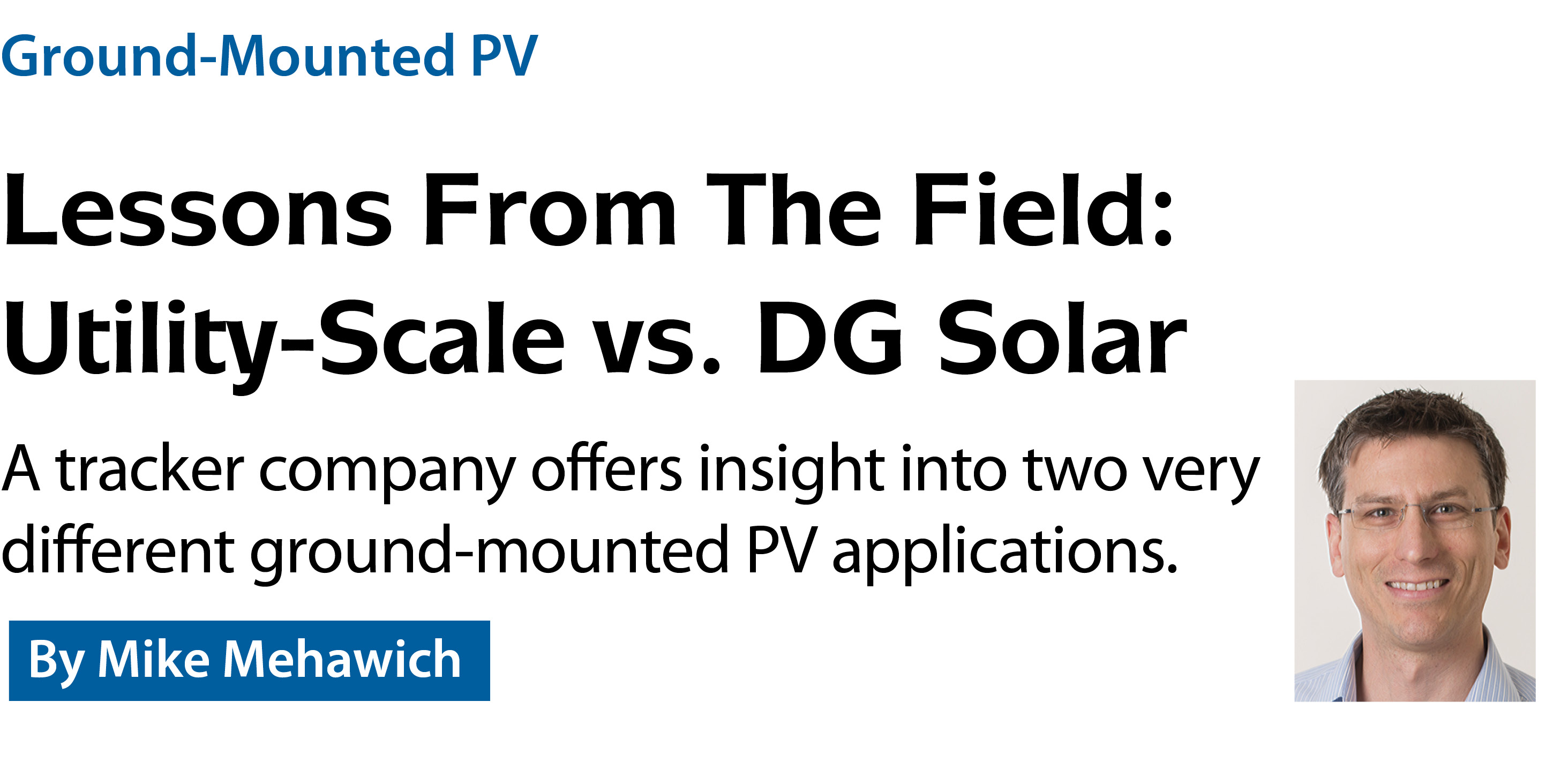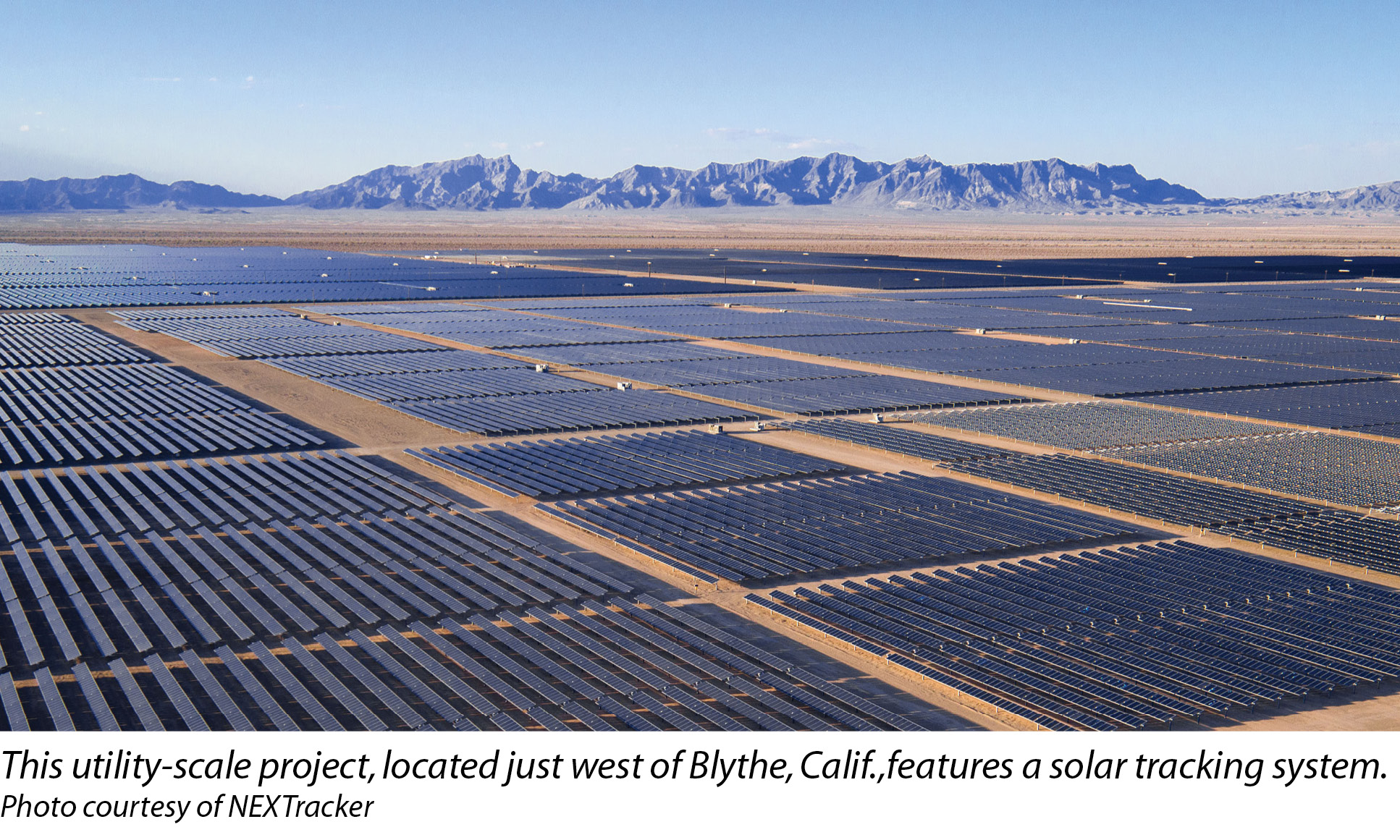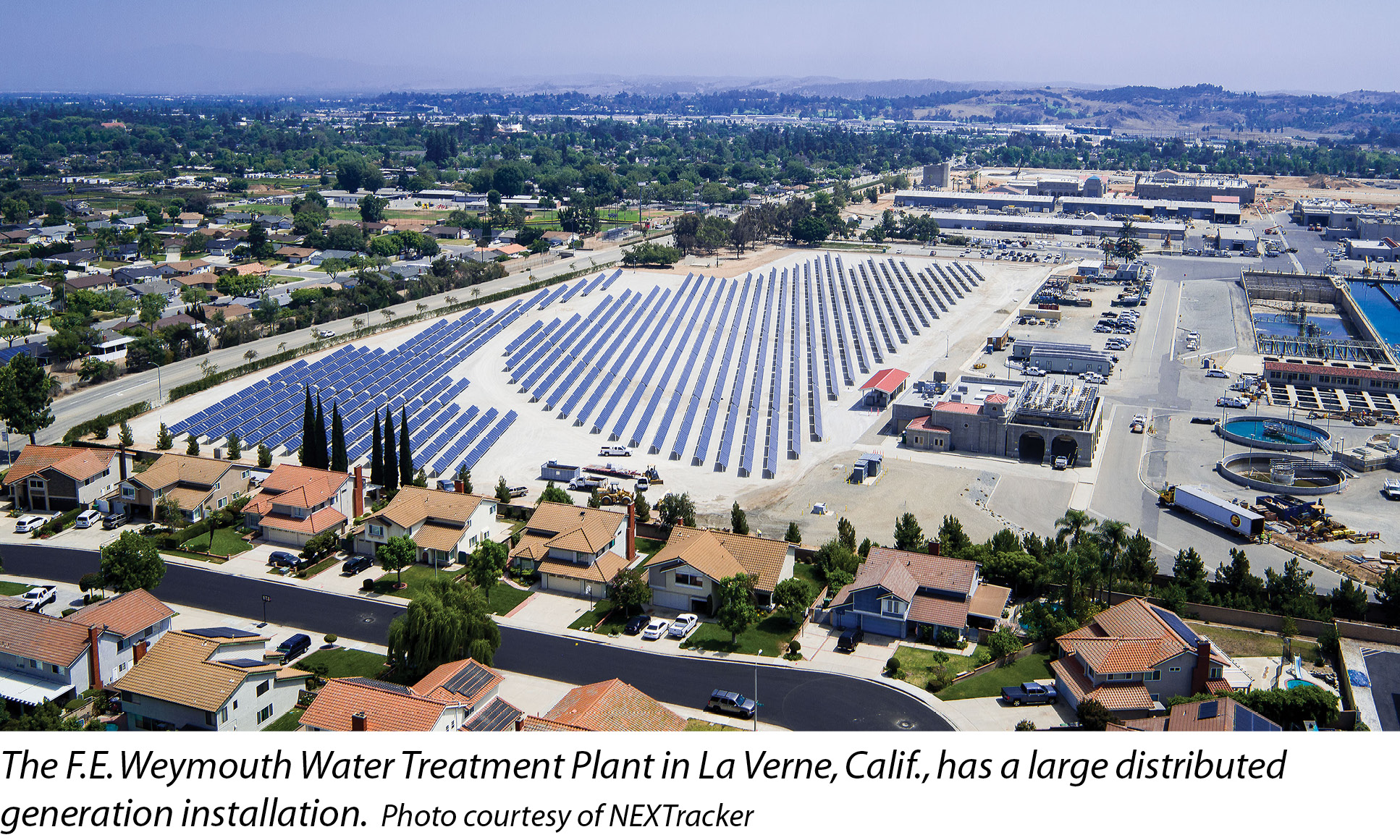

301 Moved Permanently
Ground-mounted solar power arrays are taking root around the world - increasingly displacing traditional fossil fuel power plants with clean, renewable electricity generation. However, system developers and installers face different challenges as they deploy ground-mounted solar in two key - yet distinct - application segments: utility-scale and distributed generation (DG).
Significant differences in utility-scale versus DG may manifest in all phases of a project, from planning and design to logistics and construction. There are variations in process and execution on the technical side (e.g., system design, mechanical, and electrical and civil engineering), as well as on the commercial side (e.g., contracts and procurement).
We’d like to share our experiences and lessons learned from developing solar tracking technologies and installing both types of power systems. In this article, we’ll explore key considerations in the planning and approvals process; system design and layout; labor and project management; installation methods and speed; and grid connection.
Overview
Utility-scale systems typically provide power to many end users via the transmission grid and are often described as being “in front of the meter” - as opposed to DG systems, which are “behind the meter.” Although there is no formal bifurcation of segments by system size, utility-scale systems are typically 10 MW and larger. The aerial photos you see of large expanses of solar panels in the desert represent the archetype for centralized utility-scale solar. The end users for utility-scale power may be in one location or municipality, or they may be distributed across various nodes on a utility’s grid. The direct purchasers of utility-scale power, otherwise known as “off-takers,” often include regulated utilities and municipalities, and dealing with these entities can introduce substantial complexity into contracts.
Meanwhile, DG projects are distinguished from utility-scale projects in that the electricity off-taker and end user are generally the same entity. A DG system may be owned by an individual but is more typically associated with commercial, agricultural or industrial operations where the power is to be used on-site where it’s generated, offsetting electricity costs with clean, reliable solar electric generation. Ground-mounted DG systems typically vary in size up to 10 MW, but there is no formal cutoff.
On the utility-scale side, we’re seeing tremendous sustained growth globally, not only in established markets, but also in emerging ones, such as India and Mexico. With the December 2015 solar investment tax credit (ITC) extension passed by the U.S. Congress, concerns about a serious slowdown in the U.S. utility-scale market have been largely assuaged. We’re also seeing more cases in which utility-scale solar power purchase agreement prices match or even beat those of fossil fuel generation; this is very encouraging and points to nearly limitless long-term growth potential as global demand for energy increases.
Single-axis trackers have become a module mounting structure of choice for ground-mounted projects in numerous countries, particularly those with large utility-scale markets. Such countries include Chile, Mexico, India and the U.S. - where we’ve delivered trackers and project support services for systems as large as 327 MW.
As is the case with utility-scale, there’s more certainty in the U.S. DG market now that the federal ITC has been extended. An interesting trend is the displacement of historically popular fixed-tilt mounting structures with advanced trackers within the DG segment, mirroring what has already happened in the utility-scale market. Trackers are becoming viable and increasingly popular in DG, as the technology has evolved to provide a sufficient level of site layout flexibility and energy density, thus enabling attractive economics for owners. Trackers also often provide better compatibility with agricultural sites, even enabling dual land use, and we’ve recently seen a sizable increase in demand in this subsegment. Outside of the U.S., markets such as Chile are naturally transitioning to DG as utility-scale capacity saturates local demand centers.

Planning/approvals process
Like any construction project, solar installations must be permitted and approved by local, regional and, in some cases, national authorities. Utility-scale system planning and permitting processes are more complicated than those of DG projects. The use of large tracts of land impacts a wide range of stakeholders. With utility-scale projects, there are extensive environmental reviews when it comes to land use.
U.S. developers quickly learn to navigate numerous intricacies of governmental agency (e.g., the U.S. Fish & Wildlife Service and California Environmental Protection Agency) requirements and guidelines (e.g., environmental impact statements and the California Environmental Quality Act).
Often, third-party review, reports and approvals are sought and secured from consultants and inspectors to ensure that the system conforms to requirements set by governmental agencies for land use and impacts. Only when all agencies are satisfied can project construction commence. With DG projects, approval processes are typically less extensive.
However, it’s important to note that wind speed risk categories can be different for DG projects located in the same general area as utility-scale projects, and they are often rated higher. That’s because DG projects may be located closer to densely populated areas - in contrast to the more remote areas associated with utility-scale projects. For example, certain authorities having jurisdiction require a more stringent risk category classification if the solar plant is within 1,000 feet of a freeway or dwelling. Water treatment plants also tend to carry higher risk categories due to the human life factor of service offices located on-site. Why is this important? Higher risk categories require higher wind loading, which requires careful component selection and system design that may deviate from standardized offerings.
System layout & design
System layout for customers can be challenging, depending on the size, shape and topography of the land parcel. Local wind zones, land characteristics and water features are just a few of the considerations that impact design, as well as installation and maintenance. Depending on the site, design elements such as tracker row positions, wiring, trenching and foundation depth all have to be planned in advance with supporting calculations. Equipment providers with internal design departments can help customers optimize their system designs to address these constraints.
Both DG and utility-scale projects require careful layout design; however, DG sites often have greater complexity due to mixed land use and irregular property boundaries. Thorough, precise system layouts will ensure successful array deployment.
Because utility-scale projects are usually larger than DG projects - typically encompassing hundreds of acres - and are more often rectilinear in shape, it can be a relatively straightforward process to lay out solar arrays to optimize land usage and minimize balance-of-system costs. Installers enjoy greater economies of scale with utility-scale installations, as fixed costs - such as geotechnical evaluations, equipment mobilization and project management - are spread over more acres and megawatts. Owing to larger system sizes, more of the budget can be allocated to fine-tuning design and layouts (e.g., conducting pull tests to optimize the safety factor on foundation depths).
An interesting trend in utility-scale systems is the optimization of structural design based on differential wind loading zones within the site. Foundation and mounting structure specifications may actually be varied across the exterior and interior portions of large sites, helping to reduce structural steel content while still meeting construction codes. Also, the use of an independent row architecture allows for fine-tuned optimization of structural design. Ultimately, this reduces the material costs of the system, and savings can be significant.
By contrast, DG systems call for a more standardized approach, as there is less capacity to absorb custom design optimization costs on these typically smaller systems. Generally, when planning a smaller DG project, a simple geotechnical report is used in lieu of foundation pull tests. There is often higher complexity in the array layout, as smaller land parcels located close to population centers may have irregular site boundaries and obstructions, such as drainage pipes. For these reasons, the ground-mounted DG solar market has been historically limited; the systems that were built typically utilized fixed-tilt mounting structures. Independent row tracking technology has been game-changing in this segment, providing previously unavailable design flexibility and allowing trackers to fit on small, oddly shaped sites with high energy density. This results in an attractive return on investment. Independent row tracking also reduces or eliminates site grading requirements - a key consideration in deploying DG systems, where fixed equipment mobilization costs can be significant.
Regardless of the size of the site, it’s also important to optimize the layout for operations and maintenance (O&M) access. Traditional tracking systems require access roads to enable service vehicles to access the interior portions of the array. Allocating valuable real estate for roads is clearly suboptimal in land-constrained DG sites, and this is another factor driving adoption of advanced tracking technologies that do not require separate service roads.
DG design with trackers - a closer look
DG customers require solar power systems that install quickly, perform well and involve minimal maintenance. And when it comes to land usage, the customer’s core business comes first.
Numerous DG customers, especially in agricultural regions such as California’s Central Valley, are actively seeking new technologies and techniques. Continual reinvestment in land and infrastructure has enabled many farms to successfully expand their operations and implement sustainable business practices. Solar can be an excellent fit for these customers, although it must often coexist with crops, irrigation systems, structural barriers, vegetation and easements.
DG solar systems must often be installed on irregular parcels of land in close proximity to working businesses, farms and schools. Deploying rows of independent, self-powered solar trackers could help maximize energy production by allowing more PV panels to be installed within the allotted land area. Pairing intelligent design with innovative technology and construction techniques is essential to achieving an optimal outcome for these small - yet challenging - projects.
For example, a key benefit of modular independent row trackers for DG customers is that their array rows are unencumbered by drive linkages, offering more layout flexibility - especially with respect to north-south and east-west deployment. Independent row trackers can fill in constrained spaces, such as corners on sites with diagonal borders, that might otherwise remain untapped.
Land disruption is an important concern with DG systems, and this can be alleviated by advanced tracking systems that utilize the power of the sun to directly power tracker actuator motors. When coupled with a built-in backup power supply, this technology can eliminate parasitic energy draw from the grid. Furthermore, incorporating wireless networking can eliminate external power and communication wiring and associated ground trenching, significantly reducing land impact.
The rapidly growing number of DG solar arrays springing up on commercial properties and throughout the agricultural landscape signifies that solar is becoming an increasingly mainstream resource that helps a wide range of businesses accomplish their environmental and economic objectives. DG customers are able to generate clean renewable energy and secure lower electricity rates (reducing their bills by as much as 85%) - all while improving quality of life in their regions.

Logistics & installation
Installation processes and techniques may vary somewhat for the two types of systems. The large sizes of utility-scale systems often support the use of advanced installation methods, such as “lean construction.” Labor costs vary widely by region; for most projects, there is a strong desire to minimize labor content. For utility-scale projects, this is generally achieved by careful staging of materials and tools throughout the site and utilizing specialized crews to install the system in component-based waves. For example, as one work crew is installing the base structures, another crew is following behind installing the PV modules and another is making electrical connections.
On large projects, individual crews can focus on specific tasks, resulting in an optimized division of labor that accelerates project completion. Because project sites often exceed several hundred acres, diligent on-site tracking of materials is essential, and proper quantities of spare construction parts must be specified and managed.
DG installations, due to their smaller size, may utilize more broadly trained crews responsible for multiple construction steps. Familiarity with system components and design is essential here to enable an efficient construction schedule. Equipment providers can support this by providing installation training so that crews are familiar with each step of assembly - and may even develop their own methods that work best for their specific teams.
An interesting recent development is the use of automated installation equipment to help crews do their jobs more efficiently. When small DG project sizes preclude significant advanced staging of materials, automated mobile equipment can assist construction crews by transporting materials as they build each row. These machines assist workers in positioning and deploying structural components to help accelerate assembly.
Both DG and utility-scale projects are deployed more rapidly with advanced trackers that utilize a smart supply-chain approach that facilitates construction at a faster pace. This involves careful optimization of raw material manufacturing locations; it factors in lead times, costs and customization requirements. Special attention must be paid to packaging design to ensure that materials can be packed as densely as possible - while facilitating rapid removal from containers on-site. DG and utility customers often differ in their preference for pre-assembly of components. Many of the larger utility-scale customers typically prefer to do all assembly on-site, as they have developed and honed efficient methods over many hundreds of megawatts of installations. DG customers can also benefit from pre-engineered, bundled solutions that combine trackers, string inverters, wire harnesses and system electrical design into a modular repeatable power block with a single touchpoint for procurement.
Interconnection
Solar power systems are interconnected to the grid at the conclusion of construction and commissioning. How this step is carried out depends on the off-taking utility, its infrastructure, the end user type and, potentially, other stakeholders. The mechanics of the interconnection itself are similar with both types of systems; so, too, is the actual metering (most use “revenue grade” metering). Performance monitoring and O&M activities are largely the same, with utility-scale owners using more sophisticated supervisory control and data acquisition systems, sometimes with centralized operations centers.
When it comes to tying into the grid system, DG projects are generally easier to complete because there’s usually an existing power structure that facilitates interconnection. There are exceptions, however, if the utility determines that the DG project will have a significant impact on the local distribution system due to the system size or its location on the circuit. With a DG project, you will likely be working directly with the end user; these systems often rely on simple tie-in methods that afford less complexity.
With utility-scale systems, there may be plenty of transmission line capacity to handle the output of the plant, but the project may require the construction of a substation and/or line extensions that can add significant cost. Approaches will be more complex, depending on the specific utility company, municipality or other governing body. Project developers and engineering, procurement and construction contractors have to work closely with the relevant utility involved in the project’s deployment and be prepared for the additional feasibility studies and approvals that may be required.
System developers and installers should take into account the respective challenges of DG and utility-scale projects as they deploy ground-mounted solar power systems - including the varied approaches involved in planning, design, permitting and approvals, labor and installation management, and grid connection. We hope the information detailed herein serves to inform industry professionals tackling these challenges.
Ground-Mounted PV
Lessons From The Field: Utility-Scale vs. DG Solar
By Mike Mehawich
A tracker company offers insight into two very different ground-mounted PV applications.
si body si body i si body bi si body b
si depbio
- si bullets
si sh
si subhead
pullquote
si first graph
si sh no rule
si last graph